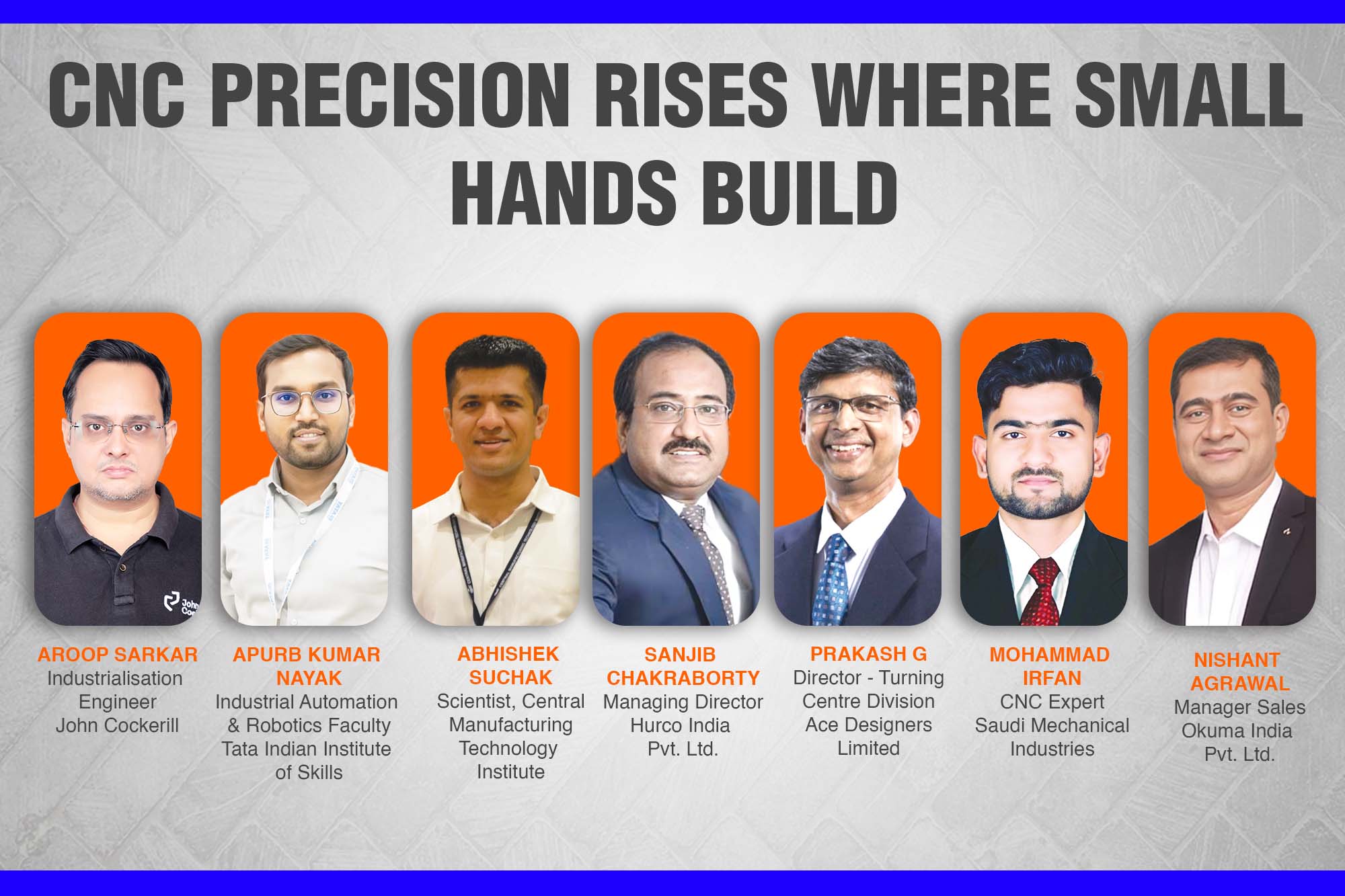In search for tech edge
By OEM Update Editorial February 28, 2024 2:29 pm IST
Automation, connectivity and analytical capabilities are enhancing MHE efficiency in the intralogistics sector, addressing the surging demands of e-commerce. Industry leaders emphasise the role of AI, IoT, and sustainability in propelling the future of material handling processes and driving automation in shaping the future of material handling processes.
Advanced material handling equipment technology promotes the sustainability of warehousing and distribution processes. The Material Handling Equipment (MHE) market is poised for substantial growth, driven primarily by the unprecedented expansion of e-commerce and the thriving manufacturing sector. According to The Business Research Company’s Material Handling Equipment Global Market Report 2024, the MHE market size has grown strongly in recent years. It is projected to grow from $193.08 billion in 2023 to $206.84 billion in 2024 at a compound annual growth rate (CAGR) of 7.1 percent. The trend of increased palletisation of loads and vertical space using high-raised racks and automation is gaining momentum.
According to Neville Mevawala, the Head of Sales & Marketing at Godrej Material Handling, online shopping has led to a substantial demand for MHE, particularly in warehousing and logistics operations. Government initiatives like Make in India and financial support for MSMEs are expected to boost investments in modern, powered, and advanced MHE further. These initiatives are facilitating significant progress in the domestic manufacturing sector.
Improving efficiency in MHE is achieved through connectivity, automation, and analytical features. Integrating warehouse management software, automation, and robotics is crucial to boosting operational efficiency and productivity in the intralogistics sector. These technological advancements enable smooth connectivity and continuous real-time monitoring of operations, empowering informed decision-making and optimising the utilisation of resources.
AI and IoT advantages
Neville highlights that AI and IoT technologies are increasing in supply chain and manufacturing processes. These advancements contribute to increased efficiency, predictive maintenance, optimised inventory management, and enhanced visibility and traceability. Real-time monitoring and analysis provided by these technologies empower companies to make updated decisions and streamline workflows, reducing operational inefficiencies.
The predictive maintenance capabilities facilitated by IoT sensors and AI algorithms enable proactive equipment maintenance, minimising downtime, preventing unexpected breakdowns, and ultimately enhancing operational reliability and cost-effectiveness. In supply chain and manufacturing processes, AI and IoT technologies offer many advantages, becoming integral to automated material handling. AI algorithms analyse extensive data for optimising inventory levels, predicting maintenance requirements, and improving demand forecasting accuracy.
Hariprasad S., the Chief Operating Officer at Toyota Material Handling India, emphasises the real-time insights provided by IoT sensors into equipment performance, enabling predictive maintenance and reducing downtime. Integrating AI and IoT enhances operational efficiency, reduces costs, and improves overall resilience in the supply chain. Neeraj Waghela, the Head of Product Development at ElectroMech Material Handling Systems (India), underscores the reliance on sensors in MHE automation, capturing various data points like distance, rotation, angle, temperature, current, and load. These sensors facilitate seamless communication of equipment movements, ensuring precise control over their motions.
Innovations for a greener future
Manufacturers are emphasising electric forklifts, conveyors, and automated guided vehicles (AGVs) powered by renewable energy sources or high-efficiency motors. The prioritisation of energy efficiency diminishes environmental impact. It also aids warehouses and distribution centres in reducing their long-term operating costs.
Furthermore, there is a growing trend among manufacturers to utilise eco-friendly materials and sustainable manufacturing processes. Embracing these practices allows equipment manufacturers to contribute to a more circular economy and minimise their environmental footprint.
Looking ahead, the future of material handling systems will revolve around addressing the demands of faster shipping, order customisation, and last-mile delivery fuelled by the surge in e-commerce. This involves the adoption of advanced robotics and automation for efficient order fulfilment, integrating AI and machine learning for predictive analytics and demand forecasting, and implementing autonomous delivery vehicles for streamlined last-mile logistics. Additionally, flexible and scalable systems will be paramount to accommodating fluctuations in demand and enabling rapid adjustments to meet evolving customer expectations.
Growing warehouse spaces
The demand for warehouse space in India is experiencing rapid growth. It is being propelled by factors such as GST implementation, the expansion of the e-commerce sector, and investments from Private Equity firms. According to Prem Kalliath, the CEO of Blue Star Engineering & Electronics, there is a remarkable increase in Grade A warehouses, which are well-suited for automation. The expanding scale of warehouse operations fuels a need for automated solutions that enhance inventory management and operational efficiency.
The overall market for material storage, movement, and handling in India is estimated to range from Rs 8,000 to Rs 10,000 crores. Warehouse automation constitutes 15 to 20 percent of this market. A focus on manufacturing drives the growth of the warehouse automation market, the growing complexity of production and warehouse processes, increased emphasis on the supply chain, and optimal space utilisation at distribution centres. The warehouse automation market is anticipated to double in the next five years, propelled further by investments in greenfield capacity, leading to increased demand for in-plant storage space.
Predictive maintenancePredictive maintenance technologies are crucial in forecasting demand, optimising inventory levels, and mitigating risks within the supply chain.
Augmented reality and virtual reality technologies are being employed to enhance warehouse efficiency and improve training programs for logistics personnel. Furthermore, predictive analytics tools are instrumental in forecasting demand, optimising inventory levels, and addressing supply chain risks. By analysing historical data and external factors, these tools assist logistics companies in anticipating and responding to changing market conditions more efficiently, resulting in improved overall operational efficiency and increased customer satisfaction.
According to Neeraj Waghela, the increasing trend towards automation is reducing reliance on human intervention, emphasising the importance of safe and synchronised operations. This shift is particularly relevant in the infrastructure and manufacturing sectors, where maintaining a consistent workforce is challenging. Automation has simplified the handling of heavy material equipment, streamlined processes, and reduced the necessity for extensive training.
Going afar
The market for material storage, movement, and handling in India is on a substantial growth trajectory, with warehouse automation expected to more than double in the next five years.
Conclusively, the future of material handling equipment is marked by integrating advanced technologies to enhance efficiency, sustainability, and adaptability in the face of growing demands. The growth in warehouse space, fuelled by factors like e-commerce expansion, drives the need for automated solutions to enhance inventory management and operational efficiency. The key to meeting the rising demand in the e-commerce space is the utilisation of advanced shuttle systems and AGVs and maximising vertical space.
Integrating AI, IoT, and automation in MHE is central for real-time monitoring, predictive maintenance, and optimising – leading to operational reliability. The innovations, such as electric forklifts and eco-friendly materials, help reduce environmental impact and operating costs. The shift towards automation addresses logistical challenges and emphasises the importance of synchronised operations. Looking ahead, the material handling systems will continue to evolve to meet the demands of faster shipping and last-mile delivery. However, there is an impending need to focus on advanced robotics, AI, ML, and autonomous delivery vehicles. Overall, integrating technologies and sustainable practices is shaping a vibrant future for material handling processes in India.
===============
Hariprasad S., Chief Operating Officer, Toyota Material Handling India Pvt. Ltd.
By leveraging data-driven insights, companies can make informed decisions, improve resource allocation, and enhance operational efficiency throughout the supply chain.
Prem Kalliath, CEO, Blue Star Engineering & Electronics
The increasing scale of warehouse operations drives demand for automated solutions that provide better inventory management and operational excellence.
Neville Mevawala, Head of Sales & Marketing, Godrej Material Handling.
The surge in online shopping has created a soaring demand for MHE, especially in warehousing and logistics operations.
Neeraj Waghela, Head Of Product Development, ElectroMech Material Handling Systems (India) Pvt. Ltd.
MHE automation relies on many sensors that enable seamless communication of all equipment movements to ensure precise control over their motions.
Cookie Consent
We use cookies to personalize your experience. By continuing to visit this website you agree to our Terms & Conditions, Privacy Policy and Cookie Policy.
















